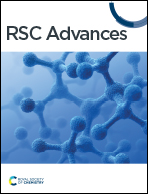Utilizing EPR spectroscopy to investigate the liquid adsorption properties of bimetallic MIL-53(Al/Cr) MOF†
Abstract
The flexibility of the MIL-53(M) metal–organic framework (MOF) has been elucidated through various characterization methodologies, particularly in gas and liquid adsorption processes. However, to the best of our knowledge, there has been no prior electron paramagnetic resonance (EPR) characterization of liquid-phase adsorption in the MOF MIL-53(M), which offers insights into local geometric changes at the oxygen octahedron containing the metal ions of the framework. In this study, we investigate, for the first time, the pore transformations within the MIL-53(Al0.99Cr0.01) framework during liquid-phase adsorption using EPR spectroscopy. Our investigation concentrates explicitly on the adsorption of pure solvents, including water, methanol, ethanol, isopropanol, pyridine, and mixed water/methanol phases. The EPR spectroscopy on the (Al0.99Cr0.01) MOF has allowed us to witness and comprehend the transitions between the narrow pore and large pore phases by examining changes in the zero-field splitting parameters of the S = 3/2 Cr(III) species. Of all the solvents examined, a robust and distinct spectral feature observed during methanol adsorption unequivocally indicates the pore opening.



 Please wait while we load your content...
Please wait while we load your content...